Barcode

A barcode is an optical machine-readable representation of data relating to the object to which it is attached. Originally barcodes systematically represented data by varying the widths and spacings of parallel lines, and may be referred to as linear or one-dimensional (1D). Later they evolved into rectangles, dots, hexagons and other geometric patterns in two dimensions (2D). Although 2D systems use a variety of symbols, they are generally referred to as barcodes as well. Barcodes originally were scanned by special optical scanners called barcode readers. Later, scanners and interpretive software became available on devices including desktop printers and smartphones.
An early use of one type of barcode in an industrial context was sponsored by the Association of American Railroads in the late 1960s. Developed by General Telephone and Electronics (GTE) and called KarTrak ACI (Automatic Car Identification), this scheme involved placing colored stripes in various combinations on steel plates which were affixed to the sides of railroad rolling stock. Two plates were used per car, one on each side, with the arrangement of the colored stripes representing things such as ownership, type of equipment, and identification number.[1] The plates were "read" by a trackside scanner located, for instance, at the entrance to a classification yard while the car was moving past.[2] The project was abandoned after about ten years because the system proved unreliable after long-term use in the field.[1]
Barcodes became commercially successful when they were used to automate supermarket checkout systems, a task for which they have become almost universal. Their use has spread to many other tasks that are generically referred to as automatic identification and data capture (AIDC). The very first scanning of the now ubiquitous Universal Product Code (UPC) barcode was on a pack of Wrigley Company chewing gum in June 1974.[3]
Other systems have made inroads in the AIDC market, but the simplicity, universality and low cost of barcodes has limited the role of these other systems until the 2000s (decade), over 40 years after the introduction of the commercial barcode, with the introduction of technologies such as radio frequency identification, or RFID.
History
In 1948 Bernard Silver, a graduate student at Drexel Institute of Technology in Philadelphia, Pennsylvania, US overheard the president of the local food chain, Food Fair, asking one of the deans to research a system to automatically read product information during checkout.[4] Silver told his friend Norman Joseph Woodland about the request, and they started working on a variety of systems. Their first working system used ultraviolet ink, but the ink faded too easily and was rather expensive.[5]
Convinced that the system was workable with further development, Woodland left Drexel, moved into his father's apartment in Florida, and continued working on the system. His next inspiration came from Morse code, and he formed his first barcode from sand on the beach. "I just extended the dots and dashes downwards and made narrow lines and wide lines out of them."[5] To read them, he adapted technology from optical soundtracks in movies, using a 500-watt incandescent light bulb shining through the paper onto an RCA935 photomultiplier tube (from a movie projector) on the far side. He later decided that the system would work better if it were printed as a circle instead of a line, allowing it to be scanned in any direction.
On 20 October 1949 Woodland and Silver filed a patent application for "Classifying Apparatus and Method", in which they described both the linear and bullseye printing patterns, as well as the mechanical and electronic systems needed to read the code. The patent was issued on 7 October 1952 as US Patent 2,612,994. In 1951, Woodland moved to IBM and continually tried to interest IBM in developing the system. The company eventually commissioned a report on the idea, which concluded that it was both feasible and interesting, but that processing the resulting information would require equipment that was some time off in the future.
IBM offered to buy the patent, but its offer was not high enough. Philco purchased their patent in 1962 and then sold it to RCA sometime later.[5]
Collins at Sylvania
During his time as an undergraduate, David Collins worked at the Pennsylvania Railroad and became aware of the need to automatically identify railroad cars. Immediately after receiving his master's degree from MIT in 1959, he started work at GTE Sylvania and began addressing the problem. He developed a system called KarTrak using blue and red reflective stripes attached to the side of the cars, encoding a six-digit company identifier and a four-digit car number.[5] Light reflected off the stripes was fed into one of two photomultipliers, filtered for blue or red.
The Boston and Maine Railroad tested the KarTrak system on their gravel cars in 1961. The tests continued until 1967, when the Association of American Railroads (AAR) selected it as a standard, Automatic Car Identification, across the entire North American fleet. The installations began on 10 October 1967. However, the economic downturn and rash of bankruptcies in the industry in the early 1970s greatly slowed the rollout, and it was not until 1974 that 95% of the fleet was labeled. To add to its woes, the system was found to be easily fooled by dirt in certain applications, which greatly affected accuracy. The AAR abandoned the system in the late 1970s, and it was not until the mid-1980s that they introduced a similar system, this time based on radio tags.[6]
The railway project had failed, but a toll bridge in New Jersey requested a similar system so that it could quickly scan for cars that had purchased a monthly pass. Then the U.S. Post Office requested a system to track trucks entering and leaving their facilities. These applications required special retroreflector labels. Finally, Kal Kan asked the Sylvania team for a simpler (and cheaper) version which they could put on cases of pet food for inventory control.
Computer Identics Corporation
In 1967, with the railway system maturing, Collins went to management looking for funding for a project to develop a black-and-white version of the code for other industries. They declined, saying that the railway project was large enough and they saw no need to branch out so quickly.
Collins then quit Sylvania and formed Computer Identics Corporation.[5] Computer Identics started working with helium–neon lasers in place of light bulbs, scanning with a mirror to locate the barcode anywhere up to several feet in front of the scanner. This made the entire process much simpler and more reliable, as well as allowing it to deal with damaged labels by reading the intact portions.
Computer Identics Corporation installed one of its first two scanning systems in the spring of 1969 at a General Motors (Buick) factory in Flint, Michigan.[5] The system was used to identify a dozen types of transmissions moving on an overhead conveyor from production to shipping. The other scanning system was installed at General Trading Company's distribution center in Carlstadt, New Jersey to direct shipments to the proper loading bay.
Universal Product Code
In 1966 the National Association of Food Chains (NAFC) held a meeting where they discussed the idea of automated checkout systems. RCA had purchased rights to the original Woodland patent, attended the meeting and initiated an internal project to develop a system based on the bullseye code. The Kroger grocery chain volunteered to test it.
In mid-1970s, the NAFC established the U.S. Supermarket Ad Hoc Committee on a Uniform Grocery Product Code, which set guidelines for barcode development and created a symbol selection subcommittee to help standardize the approach. In cooperation with consulting firm McKinsey & Co., they developed a standardized 11-digit code to identify any product. The committee then sent out a contract tender to develop a barcode system to print and read the code. The request went to Singer, National Cash Register (NCR), Litton Industries, RCA, Pitney-Bowes, IBM and many others.[7] A wide variety of barcode approaches were studied, including linear codes, RCA's bullseye concentric circle code, starburst patterns and others.
In the spring of 1971 RCA demonstrated their bullseye code at another industry meeting. IBM executives at the meeting noticed the crowds at the RCA booth and immediately developed their own system. IBM marketing specialist Alec Jablonover remembered that the company still employed Woodland, and he established a new facility in North Carolina to lead development.
In July 1972 RCA began an eighteen-month test in a Kroger store in Cincinnati. Barcodes were printed on small pieces of adhesive paper, and attached by hand by store employees when they were adding price tags. The code proved to have a serious problem. During printing, presses sometimes smear ink in the direction the paper is running, rendering the code unreadable in most orientations. A linear code, like the one being developed by Woodland at IBM, however, was printed in the direction of the stripes, so extra ink simply makes the code "taller" while remaining readable, and on 3 April 1973 the IBM UPC was selected by NAFC as their standard. IBM had designed five versions of the UPC symbology for future industry requirements: UPC A, B, C, D, and E.[8]
NCR installed a testbed system at Marsh's Supermarket in Troy, Ohio, near the factory that was producing the equipment. On 26 June 1974, Clyde Dawson pulled a 10-pack of Wrigley's Juicy Fruit gum out of his basket and it was scanned by Sharon Buchanan at 8:01 am. The pack of gum and the receipt are now on display in the Smithsonian Institution. It was the first commercial appearance of the UPC.[9]
In 1971 IBM had assembled a team for an intensive planning session, day after day, 12 to 18 hours a day, to thrash out how the whole system might operate and to schedule a roll-out plan. By 1973 they were meeting with grocery manufacturers to introduce the symbol that would need to be printed on the packaging or labels of all of their products. There were no cost savings for a grocery to use it unless at least 70% of the grocery's products had the barcode printed on the product by the manufacturer. IBM was projecting that 75% would be needed in 1975. Even though that was achieved, there were still scanning machines in fewer than 200 grocery stores by 1977.[10]
Economic studies conducted for the grocery industry committee projected over $40 million in savings to the industry from scanning by the mid-1970s. Those numbers were not achieved in that time-frame and some predicted the demise of barcode scanning. The usefulness of the barcode required the adoption of expensive scanners by a critical mass of retailers while manufacturers simultaneously adopted barcode labels. Neither wanted to move first and results were not promising for the first couple of years, with Business Week proclaiming "The Supermarket Scanner That Failed" in a 1976 article.[9][11]
Experience with barcode scanning in those stores revealed additional benefits. The detailed sales information acquired by the new systems allowed greater responsiveness to customer needs. This was reflected in the fact that about 5 weeks after installing barcode scanners, sales in grocery stores typically started climbing and eventually leveled off at a 10–12% increase in sales that never dropped off. There also was a 1–2% decrease in operating cost for the stores that enabled them to lower prices to increase market share. It was shown in the field that the return on investment for a barcode scanner was 41.5%. By 1980, 8,000 stores per year were converting.[10]
The global public launch of the barcode was greeted with minor skepticism from conspiracy theorists, who considered barcodes to be an intrusive surveillance technology, and from some Christians who thought the codes hid the number 666, representing the number of the beast.[12] Television host Phil Donahue described barcodes as a "corporate plot against consumers".[13]
Industrial adoption
In 1981, the United States Department of Defense adopted the use of Code 39 for marking all products sold to the United States military. This system, Logistics Applications of Automated Marking and Reading Symbols (LOGMARS), is still used by DoD and is widely viewed as the catalyst for widespread adoption of barcoding in industrial uses.[14]
Use
Barcodes such as the UPC have become a ubiquitous element of modern civilization, as evidenced by their enthusiastic adoption by stores around the world; most items other than fresh produce from a grocery store now have UPC barcodes. This helps track items and also reduces instances of shoplifting involving price tag swapping, although shoplifters can now print their own barcodes.[15] In addition, retail chain membership cards (issued mostly by grocery stores and specialty "big box" retail stores such as sporting equipment, office supply, or pet stores) use barcodes to uniquely identify consumers, allowing for customized marketing and greater understanding of individual consumer shopping patterns. At the point of sale, shoppers can get product discounts or special marketing offers through the address or e-mail address provided at registration.

They are widely used in the healthcare and hospital settings, ranging from patient identification (to access patient data, including medical history, drug allergies, etc.) to creating SOAP Notes[16] with barcodes to medication management. They are also used to facilitate the separation and indexing of documents that have been imaged in batch scanning applications, track the organization of species in biology,[17] and integrate with in-motion checkweighers to identify the item being weighed in a conveyor line for data collection.
They can also be used to keep track of objects and people; they are used to keep track of rental cars, airline luggage, nuclear waste, registered mail, express mail and parcels. Barcoded tickets allow the holder to enter sports arenas, cinemas, theatres, fairgrounds, and transportation, and are used to record the arrival and departure of vehicles from rental facilities etc. This can allow proprietors to identify duplicate or fraudulent tickets more easily. Barcodes are widely used in shop floor control applications software where employees can scan work orders and track the time spent on a job.
Barcodes are also used in some kinds of non-contact 1D and 2D position sensors. A series of barcodes are used in some kinds of absolute 1D linear encoder. The barcodes are packed close enough together that the reader always has one or two barcodes in its field of view. As a kind of fiducial marker, the relative position of the barcode in the field of view of the reader gives incremental precise positioning, in some cases with sub-pixel resolution. The data decoded from the barcode gives the absolute coarse position. An "address carpet", such as Howell's binary pattern and the Anoto dot pattern, is a 2D barcode designed so that a reader, even though only a tiny portion of the complete carpet is in the field of view of the reader, can find its absolute X,Y position and rotation in the carpet.[18][19]
Some 2D barcodes embed a hyperlink to a web page. A capable cellphone might be used to read the pattern and browse the linked website, which can help a shopper find the best price for an item in the vicinity. Since 2005, airlines use an IATA-standard 2D barcode on boarding passes (Bar Coded Boarding Pass (BCBP)), and since 2008 2D barcodes sent to mobile phones enable electronic boarding passes.[20]
Some applications for barcodes have fallen out of use. In the 1970s and 1980s, software source code was occasionally encoded in a barcode and printed on paper (Cauzin Softstrip and Paperbyte[21] are barcode symbologies specifically designed for this application), and the 1991 Barcode Battler computer game system used any standard barcode to generate combat statistics.
In the 21st century, many artists have started using barcodes in art, such as Scott Blake's Barcode Jesus, as part of the post-modernism movement.
Symbologies
The mapping between messages and barcodes is called a symbology. The specification of a symbology includes the encoding of the single digits/characters of the message as well as the start and stop markers into bars and space, the size of the quiet zone required to be before and after the barcode as well as the computation of a checksum.
Linear symbologies can be classified mainly by two properties:
- Continuous vs. discrete
- Characters in discrete symbologies are composed of n bars and n−1 spaces. There is an additional space between characters, but it does not convey information, and may be any width as long as it is not confused with the end of the code.
- Characters in continuous symbologies are composed of n bars and n spaces, and usually abut, with one character ending with a space and the next beginning with a bar, or vice versa. A special end pattern that has bars on both ends is required to end the code.
- Two-width vs. many-width
- A two-width, also called a binary bar code, contains bars and spaces of two widths, "wide" and "narrow". The precise width of the wide bars and spaces is not critical; typically it is permitted to be anywhere between 2 to 3 times the width of the narrow equivalents.
- Some other symbologies use bars of two different heights, or the presence or absence of bars. These are normally also considered binary bar codes.
- Bars and spaces in many-width symbologies are all multiples of a basic width called the module; most such codes use four widths of 1, 2, 3 and 4 modules.
Some symbologies use interleaving. The first character is encoded using black bars of varying width. The second character is then encoded, by varying the width of the white spaces between these bars. Thus characters are encoded in pairs over the same section of the barcode. Interleaved 2 of 5 is an example of this.
Stacked symbologies repeat a given linear symbology vertically.
The most common among the many 2D symbologies are matrix codes, which feature square or dot-shaped modules arranged on a grid pattern. 2D symbologies also come in circular and other patterns and may employ steganography, hiding modules within an image (for example, DataGlyphs).
Linear symbologies are optimized for laser scanners, which sweep a light beam across the barcode in a straight line, reading a slice of the barcode light-dark patterns. Stacked symbologies are also optimized for laser scanning, with the laser making multiple passes across the barcode.
In the 1990s development of charge coupled device (CCD) imagers to read barcodes was pioneered by Welch Allyn. Imaging does not require moving parts, as a laser scanner does. In 2007, linear imaging had begun to supplant laser scanning as the preferred scan engine for its performance and durability.
2D symbologies cannot be read by a laser as there is typically no sweep pattern that can encompass the entire symbol. They must be scanned by an image-based scanner employing a CCD or other digital camera sensor technology.
Scanners (barcode readers)
The earliest, and still the cheapest, barcode scanners are built from a fixed light and a single photosensor that is manually "scrubbed" across the barcode.
Barcode scanners can be classified into three categories based on their connection to the computer. The older type is the RS-232 barcode scanner. This type requires special programming for transferring the input data to the application program.
"Keyboard interface scanners" connect to a computer using a PS/2 or AT keyboard–compatible adaptor cable (a "keyboard wedge"). The barcode's data is sent to the computer as if it had been typed on the keyboard.
Like the keyboard interface scanner, USB scanners are easy to install and do not need custom code for transferring input data to the application program. On PCs running Windows the HID interface emulates the data merging action of a hardware "keyboard wedge", and the scanner automatically behaves like an additional keyboard.
Many phones are able to decode barcodes using their built-in camera, as well. Google's mobile Android operating system uses both their own Google Goggles application or third party barcode scanners like Scan.[22] Nokia's Symbian operating system features a barcode scanner,[23] while mbarcode[24] is a QR code reader for the Maemo operating system. In the Apple iOS, a barcode reader is not natively included but more than fifty paid and free apps are available with both scanning capabilities and hard-linking to URI. With BlackBerry devices, the App World application can natively scan barcodes and load any recognized Web URLs on the device's Web browser. Windows Phone 7.5 is able to scan barcodes through the Bing search app. However, these devices are not designed specifically for the capturing of barcodes. As a result, they do not decode nearly as quickly or accurately as a dedicated barcode scanner or portable data terminal.
Quality control and verification
Barcode verification examines scanability and the quality of the barcode in comparison to industry standards and specifications. Barcode verifiers are primarily used by businesses that print and use barcodes. Any trading partner in the supply chain can test barcode quality. It is important to verify a barcode to ensure that any reader in the supply chain can successfully interpret a barcode with a low error rate. Retailers levy large penalties for non-compliant barcodes. These chargebacks can reduce a manufacturer's revenue by 2% to 10%.[25]
A barcode verifier works the way a reader does, but instead of simply decoding a barcode, a verifier performs a series of tests. For linear barcodes these tests are:
- Edge Determination
- Minimum Reflectance
- Symbol Contrast
- Minimum Edge Contrast
- Modulation
- Defects
- Decode
- Decodability
2D matrix symbols look at the parameters:
- Symbol Contrast
- Modulation
- Decode
- Unused Error Correction
- Fixed (finder) Pattern Damage
- Grid Non-uniformity
- Axial Non-uniformity[26]
Depending on the parameter, each ANSI test is graded from 0.0 to 4.0 (F to A), or given a pass or fail mark. Each grade is determined by analyzing the scan reflectance profile (SRP), an analog graph of a single scan line across the entire symbol. The lowest of the 8 grades is the scan grade and the overall ISO symbol grade is the average of the individual scan grades. For most applications a 2.5 (C) is the minimum acceptable symbol grade.[27]
Compared with a reader, a verifier measures a barcode's optical characteristics to international and industry standards. The measurement must be repeatable and consistent. Doing so requires constant conditions such as distance, illumination angle, sensor angle and verifier aperture. Based on the verification results, the production process can be adjusted to print higher quality barcodes that will scan down the supply chain.
Barcode verifier standards
- Barcode verifiers should comply with the ISO/IEC 15426-1 (linear) or ISO/IEC 15426-2 (2D).
This standard defines the measuring accuracy of a barcode verifier.
- The current international barcode quality specification is ISO/IEC 15416 (linear) and ISO/IEC 15415 (2D). The European Standard EN 1635 has been withdrawn and replaced by ISO/IEC 15416. The original U.S. barcode quality specification was ANSI X3.182. (UPCs used in the US – ANSI/UCC5).
This standard defines the quality requirements for barcodes and Matrix Codes (also called Optical Codes).
- As of 2011 the ISO workgroup JTC1 SC31 was developing a Direct Part Marking (DPM) quality standard : ISO/IEC TR 29158.[28]
International standards are available from the International Organization for Standardization (ISO).[29]
These standards are also available from local/national standardization organizations, such as ANSI, BSI, DIN, NEN and others.
Benefits
In point-of-sale management, barcode systems can provide detailed up-to-date information on the business, accelerating decisions and with more confidence. For example:
- Fast-selling items can be identified quickly and automatically reordered.
- Slow-selling items can be identified, preventing inventory build-up.
- The effects of merchandising changes can be monitored, allowing fast-moving, more profitable items to occupy the best space.
- Historical data can be used to predict seasonal fluctuations very accurately.
- Items may be repriced on the shelf to reflect both sale prices and price increases.
- This technology also enables the profiling of individual consumers, typically through a voluntary registration of discount cards. While pitched as a benefit to the consumer, this practice is considered to be potentially dangerous by privacy advocates.
Besides sales and inventory tracking, barcodes are very useful in logistics and supply chain management.
- When a manufacturer packs a box for shipment, a Unique Identifying Number (UID) can be assigned to the box.
- A database can link the UID to relevant information about the box; such as order number, items packed, quantity packed, destination, etc.
- The information can be transmitted through a communication system such as Electronic Data Interchange (EDI) so the retailer has the information about a shipment before it arrives.
- Shipments that are sent to a Distribution Center (DC) are tracked before forwarding. When the shipment reaches its final destination, the UID gets scanned, so the store knows the shipment's source, contents, and cost.
Barcode scanners are relatively low cost and extremely accurate compared to key-entry, with only about 1 substitution error in 15,000 to 36 trillion characters entered.[30] The exact error rate depends on the type of barcode.
Types of barcodes
Linear barcodes
A first generation, "one dimensional" barcode that is made up of lines and spaces of various widths that create specific patterns.
| Example | Symbology | Continuous or discrete | Bar widths | Uses |
|---|---|---|---|---|
| Codabar | Discrete | Two | Old format used in libraries and blood banks and on airbills (out of date) | |
| Code 25 – Non-interleaved 2 of 5 | Continuous | Two | Industrial | |
| Code 25 – Interleaved 2 of 5 | Continuous | Two | Wholesale, libraries International standard ISO/IEC 16390 | |
 | Code 11 | Discrete | Two | Telephones (out of date) |
 | Farmacode or Code 32 | Discrete | Two | Italian pharmacode – use Code 39 (no international standard available) |
 | Code 39 | Discrete | Two | Various – international standard ISO/IEC 16388 |
 | Code 49 | Continuous | Many | Various |
 | Code 93 | Continuous | Many | Various |
 | Code 128 | Continuous | Many | Various – International Standard ISO/IEC 15417 |
| CPC Binary | Discrete | Two | ||
 | DX film edge barcode | Neither | Tall/short | Color print film |
 | EAN 2 | Continuous | Many | Addon code (magazines), GS1-approved – not an own symbology – to be used only with an EAN/UPC according to ISO/IEC 15420 |
 | EAN 5 | Continuous | Many | Addon code (books), GS1-approved – not an own symbology – to be used only with an EAN/UPC according to ISO/IEC 15420 |
 | EAN-8, EAN-13 | Continuous | Many | Worldwide retail, GS1-approved – International Standard ISO/IEC 15420 |
| Facing Identification Mark | Discrete | Two | USPS business reply mail | |
| GS1-128 (formerly named UCC/EAN-128), incorrectly referenced as EAN 128 and UCC 128 | Continuous | Many | Various, GS1-approved – just an application of the Code 128 (ISO/IEC 15417) using the ANS MH10.8.2 AI Datastructures. It is not a separate symbology. | |
 | GS1 DataBar, formerly Reduced Space Symbology (RSS) | Continuous | Many | Various, GS1-approved |
| Intelligent Mail barcode | Discrete | 4 bar heights | United States Postal Service, replaces both POSTNET and PLANET symbols (formerly named OneCode) | |
| ITF-14 | Continuous | Two | Non-retail packaging levels, GS1-approved – is just an Interleaved 2/5 Code (ISO/IEC 16390) with a few additional specifications, according to the GS1 General Specifications | |
 | JAN | Continuous | Many | Used in Japan, similar and compatible with EAN-13 (ISO/IEC 15420) |
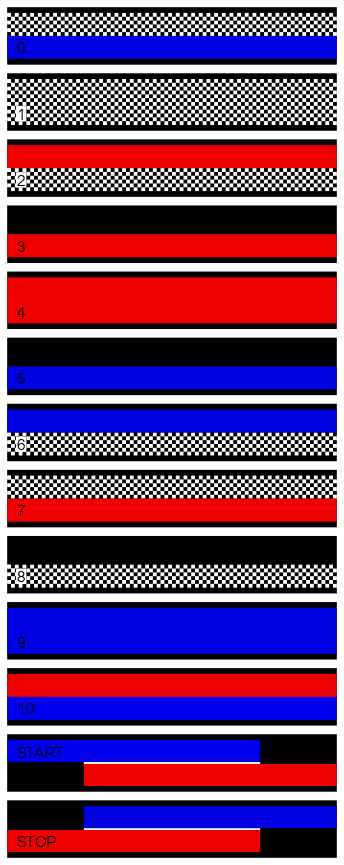 | KarTrak ACI | Discrete | Coloured bars | Used in North America on railroad rolling equipment |
 | MSI | Continuous | Two | Used for warehouse shelves and inventory |
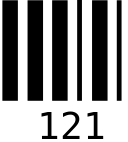 | Pharmacode | Discrete | Two | Pharmaceutical packaging (no international standard available) |
| PLANET | Continuous | Tall/short | United States Postal Service (no international standard available) | |
| Plessey | Continuous | Two | Catalogs, store shelves, inventory (no international standard available) | |
| PostBar | Discrete | 4 bar heights | Canadian Post office | |
| POSTNET | Discrete | Tall/short | United States Postal Service (no international standard available) | |
 | RM4SCC / KIX | Discrete | 4 bar heights | Royal Mail / Royal TPG Post |
| Telepen | Continuous | Two | Libraries (UK) | |
 | Universal Product Code | Continuous | Many | Worldwide retail, GS1-approved – International Standard ISO/IEC 15420 |
Matrix (2D) barcodes
A matrix code, also termed a 2D barcode or simply a 2D code, is a two-dimensional way to represent information. It is similar to a linear (1-dimensional) barcode, but can represent more data per unit area.
| Example | Name | Notes |
|---|---|---|
 | Aztec Code | Designed by Andrew Longacre at Welch Allyn (now Honeywell Scanning and Mobility). Public domain. – International Standard ISO/IEC 24778 |
| Code 1 | Public domain. Code 1 is currently used in the health care industry for medicine labels and the recycling industry to encode container content for sorting.[31] | |
| ColorCode | ColorZip[32] developed colour barcodes that can be read by camera phones from TV screens; mainly used in Korea.[33] | |
| Color Construct Code | Color Construct Code is one of the few barcode symbologies designed to take advantage of multiple colors.[34][35] | |
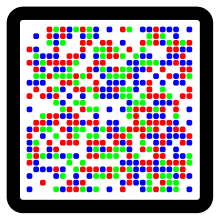 | CrontoSign |
CrontoSign (also called photoTAN) is a visual cryptogram[36] containing encrypted order data and a one-time-use TAN.[37] |
| CyberCode | From Sony. | |
| d-touch | readable when printed on deformable gloves and stretched and distorted[38][39] | |
| DataGlyphs | From Palo Alto Research Center (also termed Xerox PARC).[40]
Patented.[41] DataGlyphs can be embedded into a half-tone image or background shading pattern in a way that is almost perceptually invisible, similar to steganography.[42][43] | |
 | Data Matrix | From Microscan Systems, formerly RVSI Acuity CiMatrix/Siemens. Public domain. Increasingly used throughout the United States. Single segment Data Matrix is also termed Semacode – Standard: ISO/IEC 16022. |
| Datastrip Code | From Datastrip, Inc. | |
 | digital paper | patterned paper used in conjunction with a digital pen to create handwritten digital documents. The printed dot pattern uniquely identifies the position coordinates on the paper. |
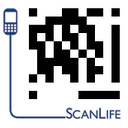 | EZcode | Designed for decoding by cameraphones;[44] from ScanLife.[45] |
 | High Capacity Color Barcode | Developed by Microsoft; licensed by ISAN-IA. |
 | Han Xin Barcode | Barcode designed to encode Chinese characters introduced by Association for Automatic Identification and Mobility in 2011. |
| HueCode | From Robot Design Associates. Uses greyscale or colour.[46] | |
| InterCode | From Iconlab, Inc. The standard 2D barcode in South Korea. All 3 South Korean mobile carriers put the scanner program of this code into their handsets to access mobile internet, as a default embedded program. | |
 | MaxiCode | Used by United Parcel Service. Now Public Domain |
| MMCC | Designed to disseminate high capacity mobile phone content via existing colour print and electronic media, without the need for network connectivity | |
 | NexCode | NexCode is developed and patented by S5 Systems. |
| Nintendo e-Reader#Dot code | Developed by Olympus Corporation to store songs, images, and mini-games for Game Boy Advance on Pokémon trading cards. | |
 | PDF417 | Originated by Symbol Technologies. Public Domain. |
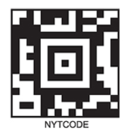 | Qode | American proprietary and patented 2D barcode from NeoMedia Technologies, Inc.[45] |
 | QR code | Initially developed, patented and owned by Toyota subsidiary Denso Wave for car parts management; they have chosen not to exercise their patent rights. Can encode Japanese Kanji and Kana characters, music, images, URLs, emails. De facto standard for Japanese cell phones. Also used with BlackBerry Messenger to pickup contacts rather than using a PIN code. These codes are also the most frequently used type to scan with smartphones. – International Standard : ISO/IEC 18004 |
 | ShotCode | Circular barcodes for camera phones. Originally from High Energy Magic Ltd in name Spotcode. Before that probably termed TRIPCode. |
 | SPARQCode | QR code encoding standard from MSKYNET, Inc. |
| VOICEYE | Developed and patented by VOICEYE, Inc. in South Korea, it aims to allow blind and visually impaired people to access printed information. It also claims to be the 2D barcode that has the world's largest storage capacity. |
Example images
- First, Second and Third Generation Barcodes
-

GTIN-12 number encoded in UPC-A barcode symbol. First and last digit are always placed outside the symbol to indicate Quiet Zones that are necessary for barcode scanners to work properly
-

EAN-13 (GTIN-13) number encoded in EAN-13 barcode symbol. First digit is always placed outside the symbol, additionally right quiet zone indicator (>) is used to indicate Quiet Zones that are necessary for barcode scanners to work properly
-

"Wikipedia" encoded in Code 93
-

"*WIKI39*" encoded in Code 39
-

'Wikipedia" encoded in Code 128
-

An example of a stacked barcode. Specifically a "Codablock" barcode.
-

PDF417 sample
-

Lorem ipsum boilerplate text as four segment Data Matrix 2D
-

"This is an example Aztec symbol for Wikipedia" encoded in Aztec Code
-

Text 'EZcode'
-

High Capacity Color Barcode of the URL for Wikipedia's article on High Capacity Color Barcode
-

"Wikipedia, The Free Encyclopedia" in several languages encoded in DataGlyphs
-

Two different 2D barcodes used in film: Dolby Digital between the sprocket holes with the "Double-D" logo in the middle, and Sony Dynamic Digital Sound in the blue area to the left of the sprocket holes
-

MaxiCode example. This encodes the string "Wikipedia, The Free Encyclopedia"
-

ShotCode sample
-
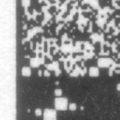
detail of Twibright Optar scan from laser printed paper, carrying 32 kbit/s Ogg Vorbis digital music (48 seconds per A4 page)
-
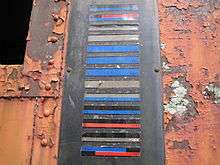
A KarTrak railroad Automatic Equipment Identification label on a caboose in Florida
- ^ (株)デンソーウェーブ, denso-wave.com (Japanese) Copyright
In popular culture
In architecture, a building in Lingang New City by German architects Gerkan, Marg and Partners incorporates a barcode design,[47] as does a shopping mall called Shtrikh-kod (the Russian for barcode) in Narodnaya ulitsa ("People's Street") in the Nevskiy district of St. Petersburg, Russia.[48]
In media, in 2011, the National Film Board of Canada and ARTE France launched a web documentary entitled Barcode.tv, which allows users to view films about everyday objects by scanning the product's barcode with their iPhone camera.[49][50]
In professional wrestling, the WWE stable D-Generation X incorporated a barcode into their entrance video, as well as on a T-shirt.[51][52]
In video games, the protagonist of the Hitman video game series has a barcode tattoo on the back of his head.
In the films Back to the Future Part II and The Handmaid's Tale, cars in the future are depicted with barcode licence plates.
In music, Dave Davies of The Kinks released a solo album in 1980, AFL1-3603, which featured a giant barcode on the front cover in place of the musician's head. The album's name was also the barcode number.
The April, 1978 issue of Mad Magazine featured a giant barcode on the cover, with the blurb "[Mad] Hopes this issue jams up every computer in the country...for forcing us to deface our covers with this yecchy UPC symbol from now on!"
See also
- Automated identification and data capture (AIDC)
- Barcode printer
- Barcode scanner
- Code (disambiguation)
- European Article Numbering-Uniform Code Council
- Global Trade Item Number
- Identifier
- Inventory control system
- ISBN
- Object hyperlinking
- Semacode
- SMS barcode
- SPARQCode
==References==Barcodes
Notes
- 1 2 Cranstone, Ian. "A guide to ACI (Automatic Car Identification)/KarTrak". CANADIAN FREIGHT CARS A resource page for the Canadian Freight Car Enthusiast. Ian Cranstone. Retrieved 26 May 2013.
- ↑ Keyes, John (22 August 2003). "KarTrak". John Keyes Boston photoblogger. Images from Boston, New England, and beyond. John Keyes. Retrieved 26 May 2013.
- ↑ Fox, Margalit (15 June 2011), "Alan Haberman, Who Ushered in the Bar Code, Dies at 81", The New York Times
- ↑ Fishman, Charles (1 August 2001). "The Killer App – Bar None". American Way. Retrieved 2010-04-19.
- 1 2 3 4 5 6 Seideman, Tony, "Barcodes Sweep the World", Wonders of Modern Technology
- ↑ Graham-White, Sean (August 1999). "Do You Know Where Your Boxcar Is?". Trains (Kalmbach Publishing) 59 (8): 48–53.
- ↑ George Laurer, "Development of the U.P.C. Symbol", bellsouthpwp.net
- ↑ Nelson, Benjamin (1997). "From Punched Cards To Bar Codes".
- 1 2 Varchaver, Nicholas (31 May 2004). "Scanning the Globe". Fortune. Archived from the original on 14 November 2006. Retrieved 2006-11-27.
- 1 2 Selmeier, Bill (2008). Spreading the Barcode. pp. 26, 214, 236, 238, 244, 245, 236, 238, 244, 245. ISBN 978-0-578-02417-2.
- ↑ Rawsthorn, Alice (23 Feb 2010). "Scan Artists". nytimes.com. Retrieved 31 Jul 2015.
- ↑ "What about barcodes and 666: The Mark of the Beast?". Av1611.org. 1999. Retrieved 2014-03-14.
- ↑ Bishop, Tricia (5 July 2004). "UPC bar code has been in use 30 years". SFgate.com. Archived from the original on 2004-08-23. Retrieved 22 December 2009.
- ↑ "Adams1.com". Adams1.com. Retrieved 2011-11-28.
- ↑ "Retrieved November 17, 2011". Iwatchsystems.com. 2 May 2011. Retrieved 2011-11-28.
- ↑ Oberfield, Craig. "QNotes Barcode System". US Patented #5296688. Quick Notes Inc. Retrieved 15 December 2012.
- ↑ National Geographic, May 2010, page 30
- ↑ David L. Hecht. "Printed Embedded Data Graphical User Interfaces". Xerox Palo Alto Research Center. IEEE Computer March 2001.
- ↑ Jon Howell and Keith Kotay. "Landmarks for absolute localization". Dartmouth Computer Science Technical Report TR2000-364, March 2000.
- ↑ "IATA.org". IATA.org. 21 November 2011. Retrieved 2011-11-28.
- ↑ "Paperbyte Bar Codes for Waduzitdo" Byte magazine, 1978 September p. 172
- ↑ "Scan".
- ↑ "Nokia Europe – Nokia N80 – Support".
- ↑ "package overview for mbarcode". Maemo.org. Archived from the original on 14 August 2010. Retrieved 28 July 2010.
- ↑ Zieger, Anne (October 2003). "Retailer chargebacks: is there an upside? Retailer compliance initiatives can lead to efficiency". Frontline Solutions. Retrieved 2 August 2011.
- ↑ Bar Code Verification Best Practice work team (May 2010). "GS1 DataMatrix: An introduction and technical overview of the most advanced GS1 Application Identifiers compliant symbology" (PDF). Global Standards 1 1.17: 34–36. Archived (PDF) from the original on 20 July 2011. Retrieved 2 August 2011.
- ↑ GS1 Bar Code Verification Best Practice work team (May 2009). "GS1 Bar Code Verification for Linear Symbols" (PDF). Global Standards 1 (4.3): 23–32. Retrieved 2 August 2011.
- ↑ "Technical committees – JTC 1/SC 31 – Automatic identification and data capture techniques". ISO. Retrieved 2011-11-28.
- ↑ "ISO web site". Iso.org. Retrieved 2011-11-28.
- ↑ Harmon and Adams(1989). Reading Between The Lines, p.13. Helmers Publishing, Inc, Peterborough, New Hampshire, USA. ISBN 0-911261-00-1.
- ↑ Adams, Russ (15 June 2009). "2-Dimensional Bar Code Page". Archived from the original on 7 July 2011. Retrieved 2011-06-06.
- ↑ "Colorzip.com". Colorzip.com. Retrieved 2011-11-28.
- ↑ "Barcodes for TV Commercials". Adverlab. 31 January 2006. Retrieved 2009-06-10.
- ↑ "About". Colour Code Technologies. Retrieved 2012-11-04.
- ↑ "Frequently Asked Questions". ColorCCode. Retrieved 2012-11-04.
- ↑ CrontoSign Image, Cronto.
- ↑ Neu bei comdirect: photoTAN [New at comdirect: photoTAN] (in German), Comdirect Bank Aktiengesellschaft, 9 April 2013.
- ↑ d-touch topological fiducial recognition, MIT.
- ↑ d-touch markers are applied to deformable gloves, MIT.
- ↑ See Xerox.com for details.
- ↑ "DataGlyphs: Embedding Digital Data". Microglyphs. 2006-05-03. Retrieved 2014-03-10.
- ↑ ""DataGlyph" Embedded Digital Data". Tauzero. Retrieved 2014-03-10.
- ↑ "DataGlyphs". Xerox. Retrieved 2014-03-10.
- ↑ "Scanbuy". Retrieved 2011-11-28.
- 1 2 Steeman, Jeroen. "Online QR Code Decoder". Retrieved 9 January 2014.
- ↑ "BarCode-1 2-Dimensional Bar Code Page". Adams. Retrieved 2009-06-10.
- ↑ Barcode Halls – gmp Archived 18 October 2011 at the Wayback Machine
- ↑ "image". Peterburg2.ru. Retrieved 2011-11-28.
- ↑ Lavigne, Anne-Marie. "Introducing Barcode.tv, a new interactive doc about the objects that surround us". NFB Blog. National Film Board of Canada. Retrieved 7 October 2011.
- ↑ Anderson, Kelly (6 October 2011). "NFB, ARTE France launch ‘Bar Code’". Reelscreen. Retrieved 7 October 2011.
- ↑ Archived 16 March 2015 at the Wayback Machine
- ↑ "Dx theme song 2009-2010". YouTube. 2009-12-19. Retrieved 2014-03-10.
Bibliography
- Automating Management Information Systems: Barcode Engineering and Implementation – Harry E. Burke, Thomson Learning, ISBN 0-442-20712-3
- Automating Management Information Systems: Principles of Barcode Applications – Harry E. Burke, Thomson Learning, ISBN 0-442-20667-4
- The Bar Code Book – Roger C. Palmer, Helmers Publishing, ISBN 0-911261-09-5, 386 pages
- The Bar Code Manual – Eugene F. Brighan, Thompson Learning, ISBN 0-03-016173-8
- Handbook of Bar Coding Systems – Harry E. Burke, Van Nostrand Reinhold Company, ISBN 978-0-442-21430-2, 219 pages
- Information Technology for Retail:Automatic Identification & Data Capture Systems – Girdhar Joshi, Oxford University Press, ISBN 0-19-569796-0, 416 pages
- Lines of Communication – Craig K. Harmon, Helmers Publishing, ISBN 0-911261-07-9, 425 pages
- Punched Cards to Bar Codes – Benjamin Nelson, Helmers Publishing, ISBN 0-911261-12-5, 434 pages
- Revolution at the Checkout Counter: The Explosion of the Bar Code – Stephen A. Brown, Harvard University Press, ISBN 0-674-76720-9
- Reading Between The Lines – Craig K. Harmon and Russ Adams, Helmers Publishing, ISBN 0-911261-00-1, 297 pages
- The Black and White Solution: Bar Code and the IBM PC – Russ Adams and Joyce Lane, Helmers Publishing, ISBN 0-911261-01-X, 169 pages
- Sourcebook of Automatic Identification and Data Collection – Russ Adams, Van Nostrand Reinhold, ISBN 0-442-31850-2, 298 pages
External links
| Wikimedia Commons has media related to Barcode. |
| ||||||||||
|
